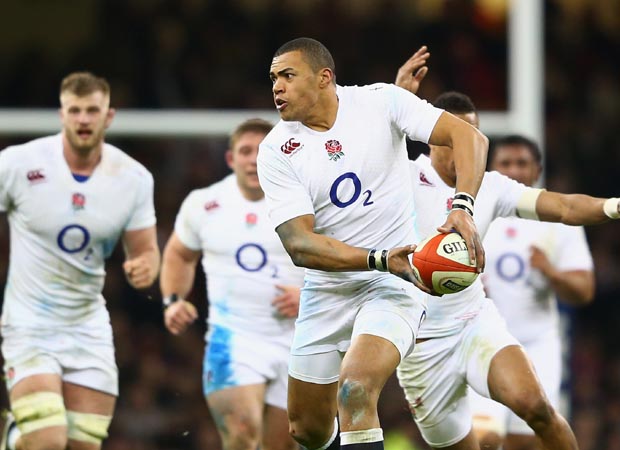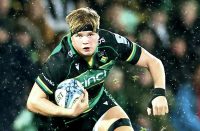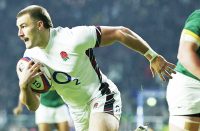 If you match-up the English and Irish backs it appears on form that they are incredibly close, but four out of seven of the Irish backs – Conor Murray, Jonny Sexton, Tommy Bowe and Rob Kearney – are Test Lions and very experienced and that gives them outstanding game management. They are very accurate and shrewd in what they do.
If you match-up the English and Irish backs it appears on form that they are incredibly close, but four out of seven of the Irish backs – Conor Murray, Jonny Sexton, Tommy Bowe and Rob Kearney – are Test Lions and very experienced and that gives them outstanding game management. They are very accurate and shrewd in what they do.
However, the England backs are also firing going into this decisive Six Nations game in Dublin. Ben Youngs is getting back to top form, his kicking is good, and he’s doing his job. George Ford has taken to international rugby so quickly that I suspect he will rarely have a bad game.
The England back with the biggest challenge on his hands is probably Luther Burrell, because, although Robbie Henshaw is only 21, he is a hard, strong, aggressive runner with a step and a hand-off.
Burrell needs to be the enforcer in that confrontation. Henshaw is pretty direct bar a little step either way, and the England 12 will have to hit him before the gain-line to win a head-to-head that is crucial to both teams.
In attack we’ve not yet seen Burrell take a really, hard aggressive line off Ford between the flanker and the fly-half. England need him to do that because, although Sexton is brave, they need to get in and shake him.
The outside-centre contest pits Jonathan Joseph against a very good footballer in Jared Payne. The Irish-Kiwi is versatile enough to play full-back and centre, and has a feel for the game in terms of when to pass and when to run. He also helps Sexton because he’s a good communicator whose skill-set gives Ireland options out wide.
Payne also tackles very well – he rarely misses – and he’ll need that against someone with Joseph’s footwork. I don’t see England fizzing the ball down the line, but, off turnover ball, Joseph will be very dangerous. If he gets five metres of space against Henshaw and Payne, they will be scrambling.
It is an old-fashioned midfield battle, with an element of the bludgeon and the rapier in both centre pairings, and that’s great to see.
In the back three Jonny May and the Simon Zebo are similar strike runners, but the Irishman has had to adapt to a Joe Schmidt gameplan which is incredibly organised and sharp.
Kearney and Mike Brown, assuming he is fit, are full-backs who are both very good in the air and like to get their own way – to the extent they can get a bit narky with the opposition, and even their own teammates, and the referee. It’s as if they need to get agitated to get the best out of themselves.
Brown has shown that he can be excellent at exploiting space, and Kearney loves to take the high ball and run on.
Then you’ve got Anthony Watson’s inexperience against an old hand like Bowe. These days Bowe is used more on the kick-pass from Sexton or Murray, but even though he may have lost a yard in pace, his anticipation and communication with his half-backs makes up for it. Bowe has 57 caps, and Sexton 47, so they know each other’s games inside out.
Against France, Bowe was also very effective on the re-starts, so Watson will have to be on his toes. Winning back a restart is like winning a strike against-the-head at the scrum. It’s a momentum shift which allows Ireland to put the squeeze on the opposition.
Murray and Sexton have a distinct advantage in confidence and experience when it comes to driving their side into pressure positions. The accuracy of their tactical kicking has other teams scrambling, and gives them the edge. No matter how well Youngs and Ford have played, Murray and Sexton have that mind-memory and muscle-memory, that gives them an advantage.
In the centres England have a slight edge. I hope Joseph keeps doing what comes to him naturally because Henshaw and Payne will put him in a tight spot. However, he will be very difficult to pin down, because while he stepped off his left twice for his tries against Wales and Italy, he went off his right foot when he set up François Louw’s try against Toulouse.
The Irish will want to shake a less experienced England backline with big early tackles. The Irish are a fit, energetic team that look comfortable within the limited attacking patterns they’ve shown. They’ve had the Schmidt chip inserted, and so far all appears to be going to plan.
Ireland have been saying all the right things about England’s attacking threat, and it’s all very friendly and welcoming – as it will be when they get to Dublin. But they must be aware of getting lulled into a convivial comfort zone, because when the first tackle comes it won’t be comfortable.
This will be one-on-one combat because the backlines are so well matched. England need their game-heads on as soon as they land. They may have won away in Wales, but they will have to show their second half intensity in Cardiff for the full 80 to win in Dublin.
The two backlines provide a sharp contrast. On the surface England, who are third in the world rugby rankings, have scored tries, and Ireland, who are fourth, have kick-chased and defended. However, there are passages of play where, contrary to that typecast, Ireland have passed the ball.
Against France in the 20th minute they moved the ball off the top of the lineout and it fizzed down the line from Murray to Zebo. From the ruck it went back to Murray and his kick into the French 22 saw Ireland on the attack in an instant.
The pass from Payne to Zebo checked him slightly, but the speed with which they had the ball in that wide 15-metre channel, where there is so much more space to beat a defender, was impressive. Ireland rely out wide on the footwork of Zebo, Bowe and Kearney, and if that pass to Zebo had been better it would have been dangerous.
The England backline isn’t as fluid in zipping the ball down the line as the Irish but they have their moves. England generally like to get into an attacking pattern with certain players in certain places, when it works it’s hard to counter as we saw against Italy with Joseph’s second try.
Ford stood about ten yards directly back from the scrum with Joseph another five yards behind him and Twelvetrees more in the fly-half slot. Vunipola got the ball out of the scrum between his legs to Youngs who fired it to Twelvetrees. Twelvetrees and Burrell ran a hard straight line at the Italian backline making it look like Burrell was coming on the crash ball.
At the optimum moment Twelvetrees, rather than a pop pass to Burrell, slipped the pass behind Burrell to Ford who was running hidden by the big English centre with Joseph alongside. The Italian defenders had been distracted enough for Ford to get the ball, put in a dummy and then just pop his pass perfectly to Joseph who was clear through a gaping whole between two defenders. There are another couple of options to be used in that set-up, so every time England run that shape it’s difficult for defenders to know which player will get the ball.
If England are successful in Dublin it will be a bigger win than against Wales, and not just because of the prospects of winning the Championship or a Grand Slam. It will be because Ireland are on a good winning run, they have more experience, they have home advantage, and they want desperately to derail England’s title ambitions.























